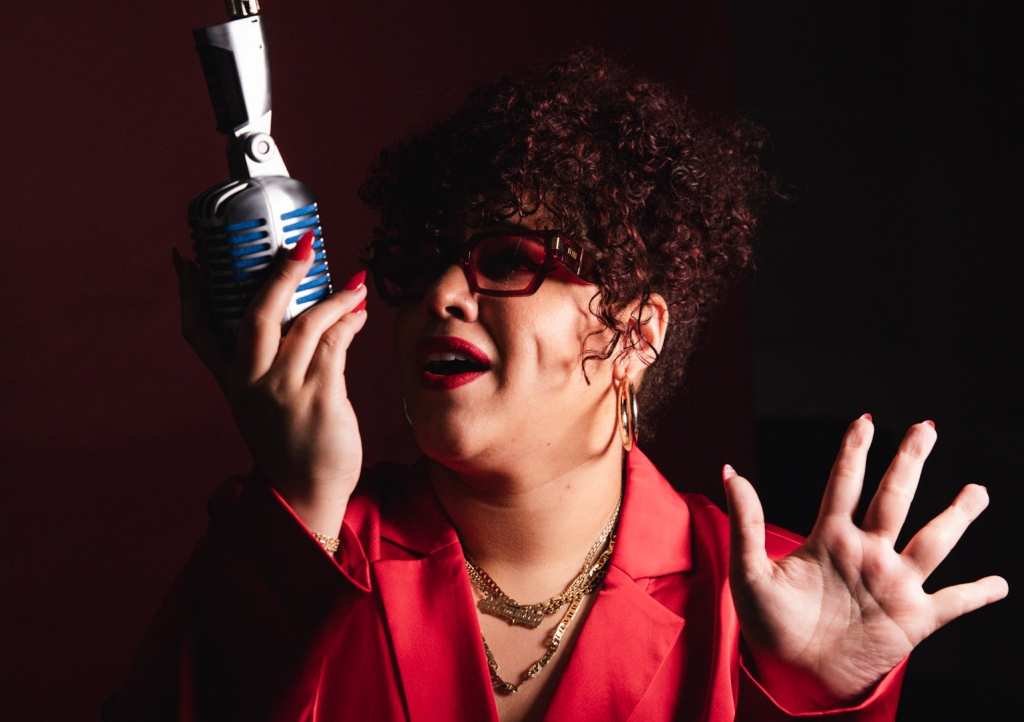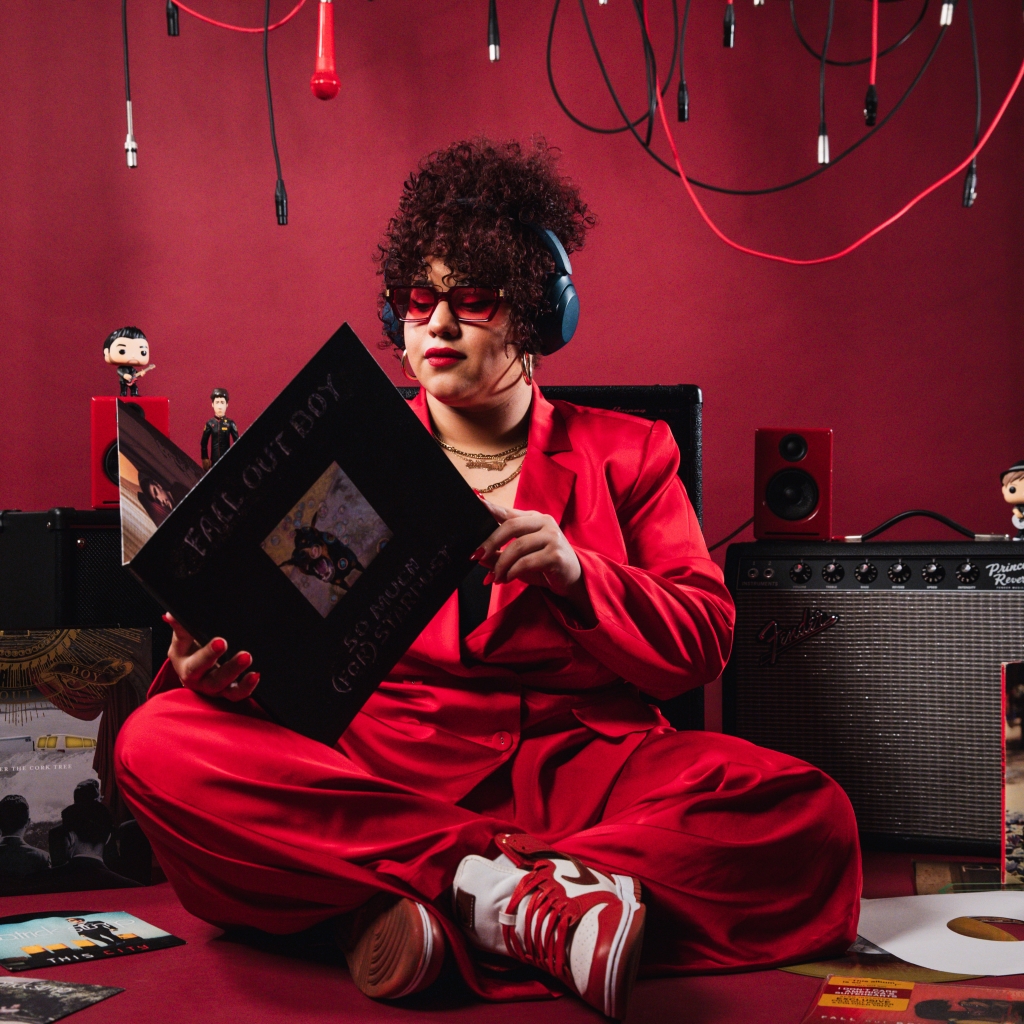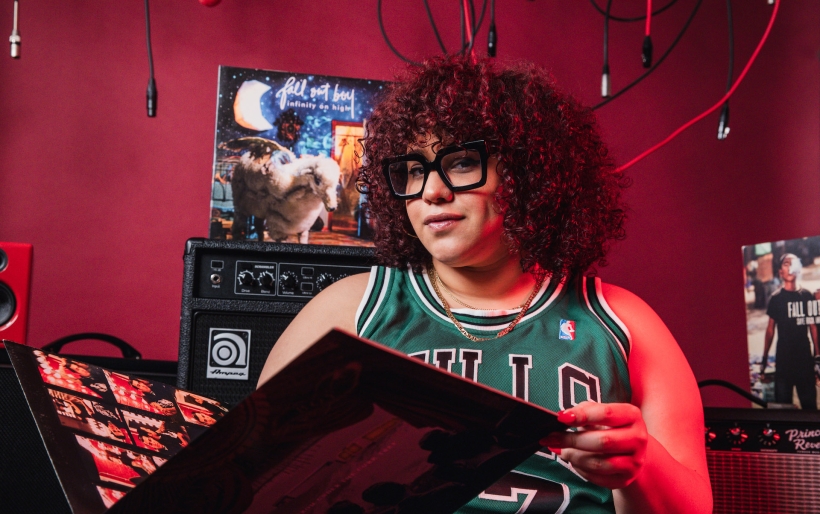Scarlet Estelle Hernandez is the membership director for REC but she moonlights as the host and creator of Sugar, We’re Going In, a podcast exploring the relationship between pop-punk/emo legends Fall Out Boy and hip-hop. Sourced from her own interviews dating back to 2011, Hernandez uses these connections as a launching pad to discuss race, culture, fandom and music.
A self-described “ethnic emo,” Hernandez discovered Fall Out Boy as a teenager and found community amongst the band’s vast fanbase. Hernandez’s love of emo and pop-punk is reflective of a broader affection that Black and Brown millennials in particular have for these primarily white bands. TikTok and Instagram are full of Black 20- and 30-somethings expressing their love for the 2000s emo that they grew up with. Let Black Twitter tell it: Hayley Williams of Paramore is damn near an adopted daughter of the Black community. Maybe its nostalgia for a formative time when guitar music and hip-hop held concurrent dominance over the pop music zeitgeist, maybe it’s the wealth of collaborations and hip-hop references coded within the music of bands like Fall Out Boy and Gym Class Heroes, but the connection is real.
We spoke with Scarlet about Fall Out Boy and why she wanted to start a podcast about her favorite band.

Scarlet Estelle Hernandez | photo by Kahleel Frazier
John Morrison: Could you tell me a little bit about yourself? You’re from Jersey, but tell me a little bit about your background.
Scarlet Estelle Hernandez: So, I am a first generation Dominican. My parents came from DR being a lawyer and a teacher, and came here to be a butcher and work at Target, and I grew up a bodega baby. So, when they started having their own businesses, I saw the behind-the-scenes, hospitality side of things. I knew what I wanted to do since I heard Fall Out Boy’s Under The Cork Tree album in 2005. I was like, “I will work in music.”
I definitely had a knack for radio and just speaking in general. And it wasn’t until I got to high school in the suburbs in Piscataway that I started radio. I did radio all four years of high school, two shows a day for five days for four years, and in 2011, I interviewed Patrick Stump.
JM: Wow. What was that like talking with him?
SEH: It was surreal ’cause by the time we got to the interview, it was the last day of tour. So we had seen each other a ton by then. I felt like I was able to get an honest conversation where he didn’t feel like he had to mask too much. It was like talking to a friend, and he made me feel really seen back in 2011 when I was just some dumb radio kid. But he also did radio in high school, so he gave me my first big in-person interview that opened a ton of doors for me.
JM: Being young and being into punk and emo, I’m assuming you knew all about the Fueled By Ramen bands and all that. What do you think drew you to that scene?
SEH: I think it was the feeling of having friends that liked what you liked? I had friends, but I didn’t feel like I had friends that I didn’t have to wear a mask around. During that time, like every band had their own little vlog series where they would take videos of themselves on tour. That was like my Marvel Cinematic Universe, they would like show up in each other’s videos and that would mean a lot to me, just seeing their friendship and personalities definitely drew me to them. And let’s be real. It was a lot of boys. So, it was like that brotherhood that they had while also making this music that I loved.
JM: As someone who’s not familiar with this scene, can you explain the relationship between Fall Out Boy and hip-hop? What’s the connection there?
SEH: Fall Out Boy is a rock band made up of hip-hop fans at the end of the day. I mean, let’s start with Pete Wentz. It wasn’t until recently, like five to 10 years ago, that people found out that he’s half Jamaican. That his mother is fully Black. And I think that opened up a lot of conversations about the whitewashing that had to happen in that scene to make that happen. But when you connect that recent information with how he was moving with (his and Stump’s indie label) decaydance and Gym Class Heroes, there’s a very obvious love and influence of hip-hop culture and hip hop fashion.
I mean, we had Patrick Stump wearing like Bape on TRL and wearing his like Roc A Fella chain and holding it out with like his two thumbs ’cause it’s probably the most expensive thing he’s ever worn. But all the way down to their collaborations, and not only the production in their albums, but the work that they did outside of Fall Out Boy, specifically Patrick. They were around in the most beautiful time. 2005 to 2007 was really where we saw hip-hop become pop music. And I’m not saying pop as the genre, but pop as in the most popular music. And even in the way the band spoke about hip-hop and their inspirations. Patrick Stump knows Mos Def’s Black on Both Sides by heart. He did an acoustic guitar cover of Big Boi’s “Shutterbug.” There’s so many things that are second nature to them, but it was something that I really celebrated because it was a perfect union of the two worlds that I loved and I lived in.

Scarlet Estelle Hernandez | photo by Kahleel Frazier
JM: Speaking of living in both of these worlds, I’ve spoken with a lot of Black and Brown punks, emo kids, metal kids, and everybody has their own unique experience navigating these overwhelmingly white music scenes. What was that experience like for you in particular?
SEH: I was very lucky to start online where my looks didn’t matter. I was on the message boards, like Falloutboyrock.com had a message board, and I was Falloutgurl732, that’s like my identity. And there I was allowed to not have my looks be the first thing that you perceive me from. And it wasn’t until I started going to Fall Out Boy shows — like my first concert, June 7th, 2007, the Honda Civic Tour, where it was Paul Wall, Fall Out Boy, The Academy Is…, Cobra Starship, +44. And I remember getting to our seats and going like this [motions trying to flatten her hair with her hands] to my hair, like trying to push it down.
And as I got older, like there were moments where in the pit, like, I would get told, “Can you put your hair away?” Or just to not take up that much space. So, it the microaggressions went on until probably pre-pandemic, where the holding space for people of color became the thing and became something openly spoken about. But even in one of my latest episodes of the podcast, I will start talking about the racism that was shown when 50 Cent was announced to tour with Fall Out Boy. And I think it’s really important to talk about that, because I think we’re all a lot more mature adults now, and I think this new generation is a lot kinder to each other. Like they’re making like bracelets for each other now, and I got my hair pulled, like I got gum thrown in my hair for going to these shows. If there was one thing about it, it was always that feeling of seeing another black or brown person and just being like… [motions like “I see you”]
JM: I’m a little older but it’s a fascinating dynamic when I see younger Black millennials that have such a deep love, excitement and appreciation for all of this music that we’re talking about. What is it emo and, and pop-punk that so deeply resonates with Black and Brown folks from your generation?
SEH: I think it’s the comradery. I think the same way that I really loved seeing this, these vlogs and seeing their behind the scenes lives. In that time pre-YouTube or right when YouTube was really popping off, it gave us that feeling of community that now is a given for when artists are online, you have to let people in. And I feel like we were the first ones to really get that in such an authentic way. It was like “Oh my God, did you watch the Cobra Starships’ new vlog? Like, oh my God. Of course.” So I think that it was a combination of that MySpace, LiveJournal all happening at the same time that really made us feel connected, not only to the music, but the musicians.
Fandom and that creation of the community around a communal art is what launched this, and made people feel like this was part of my identity. This is part of my personality. I know friends that I’ve had longer than my IRL friends because we used to go to shows together, or we met on the message boards back when we were 12, or 13. I still hang out with them and, and go to shows with them to this year. So, I think it was the comradery of “it sucks being a teenager.” Emo’s been around forever, but now emo has a name, and emo has a soundtrack and I think all that coming together really just sparked something really different in us.

Scarlet Estelle Hernandez | photo by Kahleel Frazier
JM: Could you tell me about the podcast? Fantastic name, by the way.
SEH: Sugar, We’re Going In is a podcast about Fall Out Boy and hip-hop. Tthis has been an idea I’ve had for like two years. I had a thread on Twitter go, like, semi-big and I was like, okay, I’m onto something.
So, the podcast is organized by year. I start in 2004 with the start of Decaydance. We introduce Pete, we introduce Decaydance, and we introduce Travie McCoy from Gym Class Heroes who is a huge throughline through their entire career in bridging these gaps. Travie McCoy was cool and he was putting people on to Panic! At The Disco. As a mixed man that grew up very differently from Pete Wentz, who’s a mixed man from the suburbs. There’s that understanding of experience, but in different avenues. So, with the podcast I talk about every year and I go through their albums, their music videos and give y’all hip hop connections.
We talk about Alan Ferguson who is Solange’s ex-husband, and a prolific music video director, who did about nine of their [Fueled By Ramen Records’] videos. He met Solange because Janelle Monae and Pete introduced them. Then in 2007, Jay-Z opens the Infinity On High album on a song called “Thriller,” and then — get this — the next song on that album is called “Take Over, The Breaks Over” referencing the lyric from Jay-Z’s “The Takeover” off The Blueprint in 2001.
All the way down to my favorite album, Folie a Deux, my favorite song is called “w.a.m.s,” and it’s produced by Pharrell. It wasn’t until I was older I realized, wait, there is a Neptunes four-count in this Fall Out Boy song. The presentation of it all was so beautifully put and opened up so many doors for me to know so much more about music.
JM: Where do you see the podcast going in particular? What’s your great hope for this show?
SEH: So, what’s really insane is that it started as such a little idea. And I even called it a limited run podcast, almost to like, protect my own heart, where it’s like, if it has to end, it has to end. But I’ve really brushed up my journalism skills and I love doing interviews, and I would love to be seen as a talking head that can really bridge these two worlds authentically. I get to take on the emotional labor that my Black brothers and sisters don’t have to do. They shouldn’t have to explain like why they should be here. Rock is Black, punk is black, emo is black. If this all comes from the same parts, I want to be able to be a talking head through that.
Subscribe to the Sugar, We’re Going In podcast below, via Apple Podcasts and Spotify. For more info and fun bonus content, follow the pod on Instagram at @sugarweregoingin.
